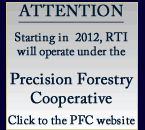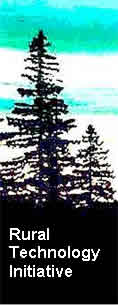 |
 |
 |
 |


|
June 2003
By Derek Churchill Save or Print a PDF copy of Fact Sheet #24
In the past, small frequent fires contributed to development of heterogeneous natural forests with wide Douglas-fir age distributions, often in discrete age classes in the southern and central Oregon Cascades (Morrison & Swanson 1990, Spies & Franklin 1991). A temporal pattern of long Douglas-fir establishment periods (60-200+ years), multiple low-to-moderate severity fires, seed source deficiencies, low initial tree densities and little competitive exclusion has been linked to the development of old growth forest conditions in this southern, drier part of the Pacific Northwest (Oliver & Larson 1996). Two recent studies of 38 old growth stands in the Oregon Cascades and Coast Range support this hypothesis (Tappeiner et. al. 1997, Poage & Tappeiner 2002). Comparisons of the growth rates in the first 50 years of old growth stands with growth rates of young stands of known densities on similar site classes, suggest that these old growth stands started at densities of 40 - 52 trees per acre (tpa). Tree sizes at ages 100, 200, and 300 years were found to be much more positively correlated with early growth rates than with site or climatic factors, suggesting that widely-spaced early stocking density, associated with a wide range of establishment periods (100-420 years), was the principal factor in the growth trajectory of individual trees (Poage & Tappeiner 2002).
In the wetter, northern part of the region, a history of larger and less frequent fires may have resulted in more homogeneous forests with narrower age distributions, which developed after large fires 500 and 700 years ago in the Cascade and Olympic Mountains (Agee 1991). It is hypothesized that at least some of these forests developed at high densities with understory exclusion and growth reduction from stocking competition (Spies et. al. 2002). Winter (2002) found evidence of this pathway in a 500-year-old stand in the southern Cascades of Washington. Using a similar comparison technique to Poage & Tappeiner (2002), she estimated a density at crown closure of 320 tpa and an establishment period of 21 years dominated by Douglas-fir. Although anecdotal evidence of this higher density pathway has been reported (Spies et. al 2002), no other published reconstruction studies have found quantitative verification of similar stand origin characteristics. While a young forest density of 320 tpa is not dissimilar to that of some planted forests, the establishment period, although much shorter than that found by Poage & Tappeiner (2002), is much longer than that of a plantation. These investigations suggest that many of today's young, previously harvested forests may be on developmental pathways that are very different from those that resulted in natural old growth stands. Young planted forests, established at high densities in very short time periods with the expectation of pre-commercial and commercial thinnings, are typically uniform and dense with little differentiation. Without density reductions, planted forests eventually evidence suppressed growth, high height to diameter ratios, and short crowns; conditions that have been shown to make stands susceptible to windthrow and inhibit the development of the large trees associated with old growth forests (Wilson & Oliver 2000). Although some researchers theorize that young stands will eventually develop old growth characteristics regardless of early establishment conditions, it will take much longer. Heavy or repeated thinning of dense young forests has been proposed as a way to silviculturally shift these stands onto a development pathway more likely to produce old forest structure with large diameter trees (Poage & Tappeiner 2002). Researchers, however, also stress the importance of creating variability by using a mix of thinning densities within stands and across the landscape (Carey et. al. 1999a, Garman 2003, Hunter 2001, Muir et. al. 2002, Franklin et. al. 2002, Spies et. al. 2002). Several studies have found that thinning accelerates the development of other old growth characteristics in addition to diameter growth. Three major research projects, the Managing for Biodiversity in Young Forests Project in western Oregon (Muir et. al. 2002), the Forest Ecosystem Study in western Washington (Carey et. al. 1999a), and the Young Stand Thinning Study on the Willamette National Forest (Hunter 2001), have undertaken comprehensive investigations into the effects of thinning. Results of these studies show that understory vegetation, shade tolerant tree regeneration, and the vertical distribution of the canopy in thinned stands tend to be more similar to old growth conditions than in un-thinned stands (Acker et. al 1998, Tappeiner et. al. 1997, Muir et. al. 2002, Bailey & Tappeiner 1998). Wildlife and plant diversity, including birds, macrolichens and bryophytes, fungi, small mammals, and bats, have also been shown to be greater in thinned stands (Carey et al. 1999, Hayes et al. 1997, Muir et. al. 2002, Hunter 2001). Different thinning strategies appear to produce different results. Thinning from below that strives for regular spacing may create a uniform light environment that leads to a thick understory of shade tolerant species with little diversity that shades out forest floor vegetation. Development of coarse woody debris, decadence, and cavities may also be delayed by heavy thinning. Removing hardwood species, wildlife trees, and snags may limit many of the habitat gains from thinning (Muir et. al. 2002). On the other hand, thinning that retains at least some of these structures and leaves patches of variable densities has been shown to increase plant and wildlife diversity even further. Under-planting shade tolerant conifers, hardwoods, and native shrubs, as well as augmenting coarse woody debris and snags can increase similarity to old-growth structure (Rapp 2002, Carey et. al. 1999a). However, even a simple thin-from-below, designed to create uniform available growing space and favor dominant crop trees, has been shown to increase wildlife and plant diversity when compared to a no action management alternative (Tappeiner 1997, Muir et al. 2002).
Whether on National Forest lands, State Forests, Tribal lands, or private lands, an ecological paradigm shift is occurring (Heiken 2003). A growing body of scientists, environmentalists and forest managers are recommending that in many forests with a prior history of harvest, continued management will be necessary to avoid the development of stagnant, overstocked stands that provide few old-growth habitats, are more susceptible to disturbance and disease, and fail to achieve the variability of pre-settlement forests. References:Acker, S.A., T.E Sabin, L.M Ganio, & W.A. McKee. (1998). Development of old-growth structure and timber volume growth trends in maturing Douglas-fir stands. Forest Ecology and Management 104 (1/3): 265-280. Agee, J. (1991). Fire history of Douglas-fir forest in the Pacific Northwest. In: Ruggerio, L.F., K.B. Aubry, A.B. Carey & M.H. Huff (Eds.), Wildlife and vegetation of unmanaged Douglas-fir forests. USDA For. Serv. Gen. Tech. Rep. PNW-GTR-285. Bailey, J.D., & J.C. Tappeiner. (1998). Effects of thinning on structural development in 40- to 100-year-old Douglas-fir stands in western Oregon. Forest Ecology & Management. 108: 99-113. Carey, A B., J. Kershner, B. Biswell, & L. Dominguez de Toledo. (1999). Ecological scale and forest development: Squirrels, dietary fungi, and vascular plants in managed and unmanaged forests. Supplement to: The Journal of Wildlife Management, Vol. 63 No. 1: Wildlife Monographs, No 142, January 1999. Carey, A.B., D.R. Thysell, & A.G. Brodie. (1999a). The Forest ecosystem study: Background, rationale, implementation, baseline conditions, and silvicultural assessment. (PNW-GTR-457). USDA Forest Service. Carey, A. B. (1998). Ecological foundations of biodiversity: lessons from natural and managed forests of the Pacific Northwest. Northwest Science 72 (special issue):127-133. Curtis, R.O., D.S. DeBell, C.A. Harrington, D.P. Lavender, J.C. Tappeiner, & J.D. Walstad. (1998). Silviculture for multiple objectives in the Douglas fir region. (PNW GTR 435). USDA Forest Service, Pacific Northwest Research Station: Portland, OR. 123 pp. Franklin, J.F., T.A. Spies et. al., (2002). Disturbances and structural development of natural forest ecosystems with silvicultural implications, using Douglas Fir forests as an example. Forest Ecology and Management 5624: 1-25. Hayes, J. P., S. S. Chan, W. H. Emmingham, J. C. Tappeiner, L. D. Kellogg, & J. D. Bailey. (1997). Wildlife response to thinning young forests on the Pacific Northwest. Journal of Forestry 95(8): 28-33. Heiken, D. (2003). A synthesis of published articles on young stand management. Oregon Natural Resource Council: Eugene, OR. http://www.efn.org/~onrcdoug/THINNING_SCIENCE.htm Hunter, M. G. (2001). Communiqué No. 3: Management in young forests. Cascade Center for Ecosystem Management: Corvallis, OR. http://www.fsl.orst.edu/ccem/pdf/Comque3.pdf Garman, S. L.; J.H. Cissel, & J.H. Mayo. (2003). Accelerating development of late-successional conditions in young managed Douglas-fir stands: A simulation study. (PNW GTR 557). USDA Forest Service, Pacific Northwest Research Station: Portland, OR. 57pp. Muir P.S. et. al. (2002). Managing for biodiversity in young Douglas-fir forests of Western Oregon. Biological Science Report. (USGS/BRD/BSR 2002 -0006). US Geological Survey, Forest and Rangeland Ecosystem Science Center: Corvallis, OR. Oliver, C.D. & Larson, B.C. (1996). Forest stand dynamics. John Wiley & Sons, Inc.: New York, NY. Poage, N.J. & J.C. Tappeiner. (2002). Long-term patterns of diameter and basal area growth of old-growth Douglas-fir trees in Western Oregon. Canadian Journal of Forest Research 32 (7): 1232-1243. Rapp, V. (2002). Science update- Restoring complexity: Second growth forests and biodiversity. USDA Forest Service, PNW Research: Olympia, WA. Spies. T.A. et al. (2002). Summary of: Workshop on development of old-growth Douglas-fir forests along the Pacific Coast of North America: A Regional Perspective. Nov. 7-9, 2001. H.J. Andrews Experimental Forest: Blue River, OR. Spies, T.A., & Franklin, J.F. (1991). The structure of natural young, mature, and old-growth Douglas-fir forests in Oregon and Washington. In: Ruggeri, L.F., K.B. Aubry, A.B. Carey, & M.H. Huff (Eds.), Wildlife and vegetation of unmanaged Douglas-fir forests. (PNW-GTR-285). USDA Forest Service. Pp. 90-109. Tappeiner, J.C., D. Huffman, D. Marshall, T.A. Spies, & J.D. Bailey, (1997). Density, ages, and growth rates in old-growth and young-growth forests in coastal Oregon. Canadian Journal of Forest Research 27: 638-648. Wilson, J.S., & C.D. Oliver. (2000). Stability and density management in Douglas-fir plantations. Canadian Journal of Forest Research 30: 910-920. Winter, L.E. (2002). Initiation of an old-growth Douglas-fir stand in the Pacific Northwest: A reconstruction from tree-ring records. Canadian Journal of Forest Research 32(6). Contacts: For more information contact Derek Churchill,
Rural Technology Initiative, University of Washington (206) 543-0827
derekch |



